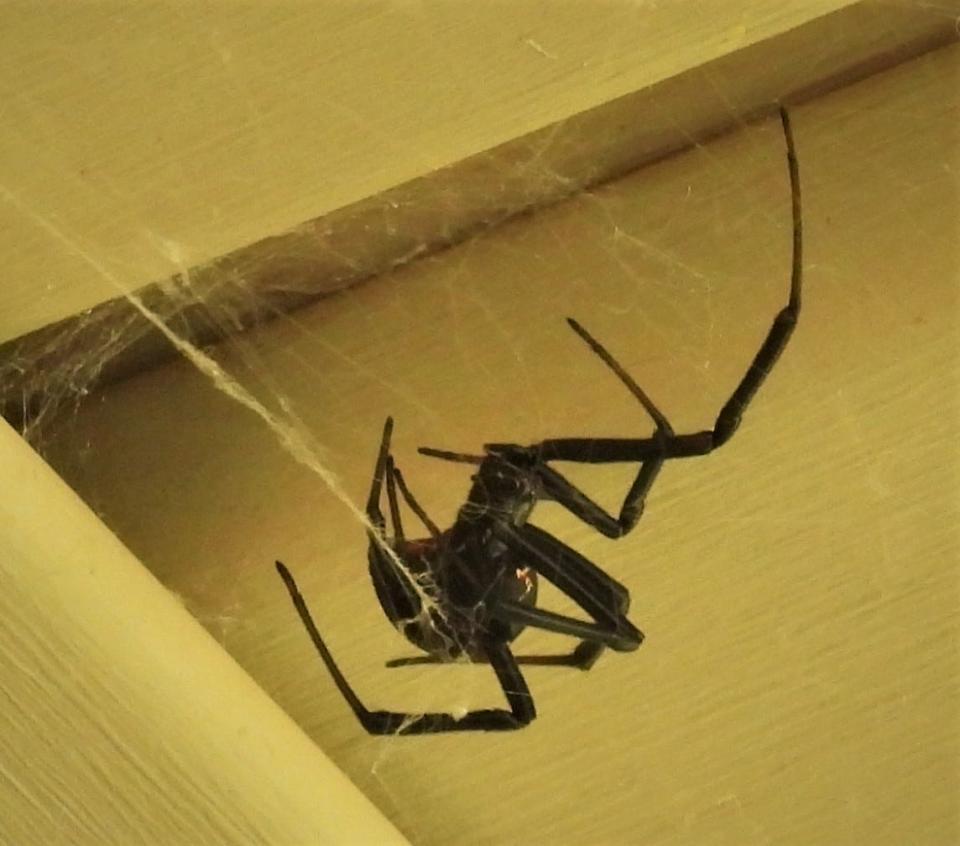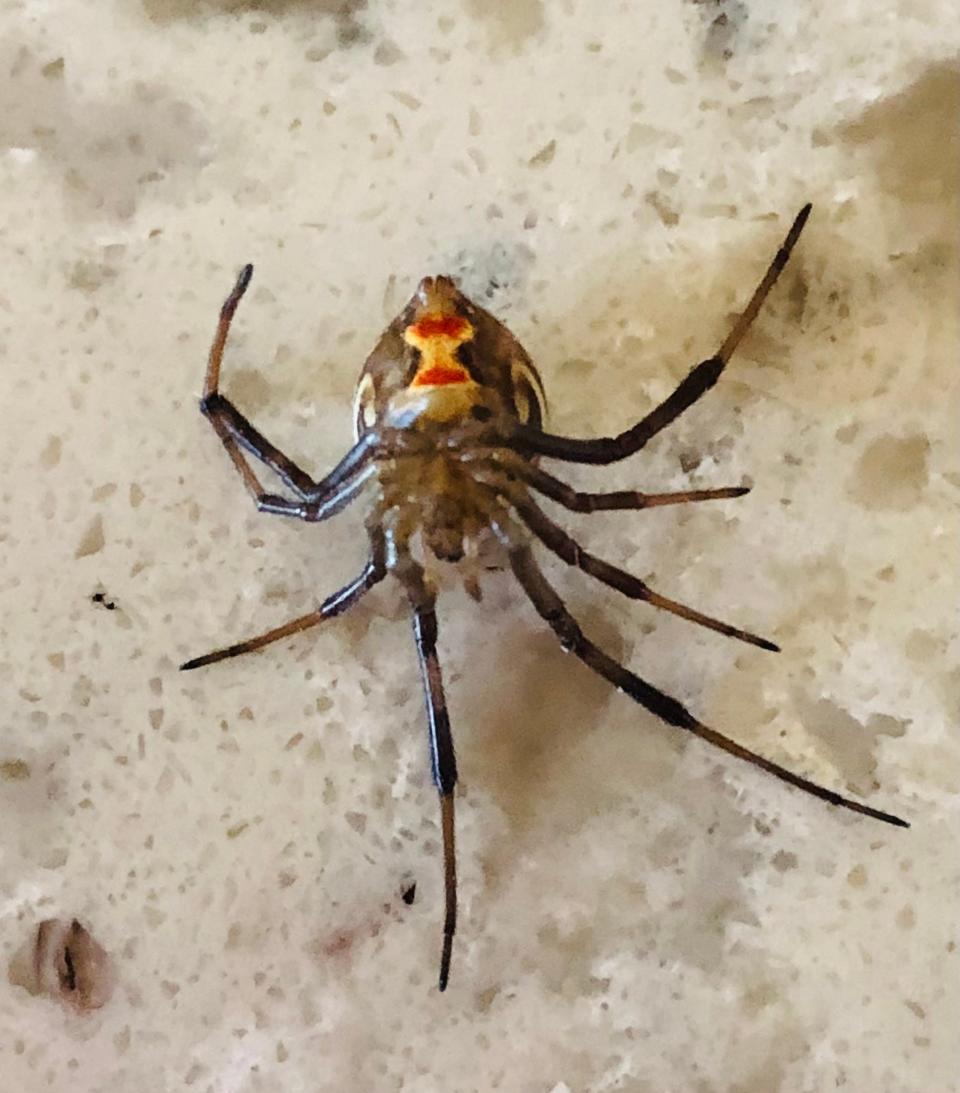Danger lurks in the dark: When to be concerned about black widow, brown recluse spiders
Of the over 46,000 known spider species, only about 200 have venom potent enough to be of medical concern. This is assuming, of course, that an individual isn’t allergic to specific components of spider venoms, just as some people are allergic to ant, bee, and wasp stings.
Only two types of spiders in north-central Texas and southwestern Oklahoma have powerful enough venom to be of medical importance. These are the Black Widow and Brown Recluse spiders. Fortunately, neither is very aggressive and both will almost always seek to avoid contact with humans. Both prefer out-of-the-way locations in which to construct webs, reside, and/or hunt their prey; but, the Brown Recluse Spider is a more mobile, ambush hunter and is occasionally encountered away from its web and/or retreat. Distinctive characteristics of both types of spiders make them relatively easy to identify.

Time's up: Look out for the black widow's hourglass mark
There are a few different species of ‘Widow’ spiders in north-central Texas and southwestern Oklahoma. The Southern Black Widow (Latrodectus mactans) is probably the most common Widow spider in our area. The base color of Black Widows is jet black, with various patterns of red, orange, yellow, and/or white markings on their abdomens. The red/orange (or sometimes yellow) colored "hourglass" or "trapezoid" shapes on the ventral side of the female’s abdomen are the most prominent, recognizable markings. Male Black Widows are significantly smaller (about 1/8 inch) than females (about 1/2 inch) and have varying patterns of red to orange dots and lines (sometimes bordered with white) on their abdomens. The closely related Brown Widow is dark brown; but also has the distinctive orange to white markings found on abdomens of Black Widows. The female Widow’s abdomen is large and globular in shape (males’ are narrower and flatter) and the legs of these web-building species are relatively long and slender.

A tangled web they weave
Black Widow spiders belong to a family called ‘cobweb’, ‘tangle-web’, and/or ‘combfoot’ spiders. Their webs are constructed in a seemingly unorganized, irregular pattern and serve as sticky, ‘tangle’ traps of insects. Other small animals (such as lizards and mice) are occasionally entangled and captured in the web and subdued by the Black Widow’s neurotoxic venom. These spiders occur in habitats ranging from woodland and agricultural areas to homes, businesses, barns, sheds, brush and wood piles, and other disturbed areas or abandoned structures. Webs are usually constructed in secluded areas and may be located high in the eaves, attics, and crawl spaces of buildings or underneath and around objects lower on the ground. Black Widows wait for suitable prey to be caught in their webs' sticky, silken threads then use specialized, comb-like bristles on the hind legs, to throw/wrap additional silk around prey before biting and injecting venom. Black Widows most frequently hunt and patrol their webs during the night.

You've been bit: Recognizing symptoms and seeking treatment
Symptoms of a Black Widow bite may begin within 30 minutes after the bite and can include muscle cramping and body aches, fever and chills, nausea, headaches, and stupor or restlessness. Symptoms may increase in severity over time and last from a few days to more than a week. Despite the neurotoxic effects of Black Widow venom, bites to humans are rarely fatal and, over the past several decades, only a few deaths have been officially attributed to Black Widow bites. However, if a black widow bite is suspected, the spider should be collected for positive identification and medical attention should be sought.

Brown recluse: Don't fiddle with danger
Only one species of recluse spider, the Brown Recluse (Loxosceles reclusa), is found in our area of Texas and Oklahoma. A common name of this species, "fiddle-backed spider," refers to a feature found on the cephalothorax. Dark brown, hair-like setae on the cephalothorax form a pattern resembling the shape of a violin, with the wider body of the violin pattern around the eyes and the narrower neck of the violin pointed toward the spider’s abdomen. The remainder of the cephalothorax and legs are usually a pale tan or yellowish color and the abdomen is a uniform tan to brown color. Both sexes are approximately the same size (1/4 to 1/2 inch length). The Brown Recluse is unusual among most spiders because it has only six eyes which are arranged in a curved pattern of three diads (or pairs). Although, the dark, violin-shaped, cephalothorax markings are easily recognized, immature spiders and some Brown Recluse populations may have paler setae and, thus, a less distinct "fiddle back."

As its name implies, the Brown Recluse tends to be reclusive and prefers residing in crevices, cracks, underneath objects, and in other dark, undisturbed outdoor areas. In houses and buildings, the Brown Recluse seems to favor attics, closets, underneath and around furniture, and bathrooms. Recluse spiders don’t climb smooth surfaces very well and are often found in bathtubs and sinks. The Brown Recluse seems to like cardboard, often using cardboard boxes as refuge and retreat areas. Consequently, these spiders may be unintentionally transported to new locations while inside or on cardboard boxes. Small, irregularly shaped webs are constructed for retreats and to protect egg sacs. The Brown Recluse is a freely moving, nocturnal insect hunter and scavenger. The hunting and hiding habits of the Recluse result in accidental contact by humans as we walk through dark areas and/or reach into a dark closet or underneath objects! The ordinarily shy Brown Recluse may bite in response to this accidental contact.
Act fast: Steps to take if bitten by brown recluse
The venom of the Brown Recluse is mainly hemolytic causing tissue death (necrosis) around the area of the bite and rupture of blood cells. Its bite usually isn’t much more painful than a bee or wasp sting and is sometimes even undetected. Skin around the bite site may become reddish and/or a small blister or pustule may develop at the site. This blister may later transition to an ulcer as tissue death occurs; but (contrary to the many images found on the Internet) severe tissue necrosis probably occurs in less than 10 percent of Brown Recluse bites. More severe reactions may include fever, muscle and joint pains, rashes, and nausea or vomiting. Young children and older adults are at greater risk from Brown Recluse bites; however, no verified deaths from a Brown Recluse bite have been reported in the United States since 2004. If bitten by a Brown Recluse (or unknown spider), you should try to collect the spider (or its remains) for positive identification and seek professional medical attention.

Safeguarding your home from unintended spider run-ins
In order to prevent and/or reduce numbers of Black Widow and Brown Recluse spiders, homeowners can remove clutter and debris from homes and yards to limit the number of potential hiding places of these spiders. Numerous pesticides are available for use as ‘barriers’ and controls around homes and yards, and sticky-board, glue traps (some advertised especially for control of the Brown Recluse spider) are available for use in homes, businesses, and other structures. A regular cleaning schedule, including sweeping and dusting, will help reduce the numbers of deposited eggs and egg sacs. It is also a good idea to wear shoes indoors (especially at night) where the Brown Recluse is known to occur and to shake out and check shoes and clothing before use because these items are good hiding places for Brown Recluse spiders!
Learning to recognize the Brown Recluse and Black Widows and where they commonly occur are the first steps to avoiding bites. A little knowledge and appropriate safety and housekeeping habits will help you avoid potentially negative encounters with these two types of spiders!

Jim Goetze is a retired professor of biology and former chairperson of the Natural Sciences Department of Laredo College with an avid interest in all aspects of the natural world. He can be contacted at [email protected]
This article originally appeared on Wichita Falls Times Record News: Know the risks of encountering black widow, brown recluse spiders
